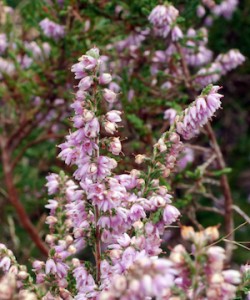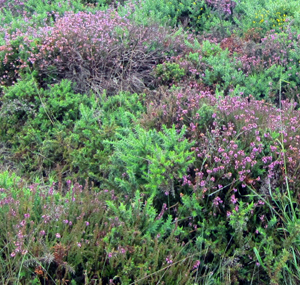Burning heather ?

Heather (Calluna vulgaris) is one of the dominant plant species of heath and moor – particularly in upland areas. In such areas, land managers may burn back areas of heather (in a selective fashion) to create better feeding for sheep or grouse. Left to grow, heather can form a ‘blanket’ that makes for poor grazing in a nutritional sense (more woody material – lignin, that is essentially indigestible) and can give rise to intense fires in dry, hot summers. The selective burning / rotational burning of heather moors has been questioned in recent times as the underlying peat, and also water quality, may degrade.
Present burning practices are estimated to release energy - some 821 PJ/yr *. However, if the U.K.’s heather was to be harvested as a biofuel or bioenergy crop** then it could yield as much energy as 1.7 million tonnes of coal per year. This would represent some 15% of the U.K.’s 2020 biomass target and it could be achieved without the loss of highly productive farm land.
Heather generally grows in ‘unproductive’ areas of heath and moorland. Professor F Worrall (Durham University) has calculated this potential energy yield from heather by :
- Determining the energy released from (dried) heather samples to calculate the energy value per M2 of heather (energy content can be calculated using calorimeters).
- Using the results of the Countryside Survey to work out the area of heather coverage throughout the U.K.
- Estimating the energy costs involved in harvesting heather and transporting it to suitable incinerators.
 Clearly, there would be problems in using heather – not the least of which being the 'ingrained' tradition of land use,but here would also be problems with cutting / harvesting / baling, without damage to the ecology and stability of these special ecosystems.
Clearly, there would be problems in using heather – not the least of which being the 'ingrained' tradition of land use,but here would also be problems with cutting / harvesting / baling, without damage to the ecology and stability of these special ecosystems.
(Note : Some heather is currently harvested and baled as a seed source, for using in re-establishing heather on old conifer plantation sites).
* PJ = Petajoule: unit of energy measurement equal to1015 joules
** elephant grass (aka Miscanthus) and short rotation coppice (note : link downloads and opens a pdf) are examples of bioenergy crops in the U.K.
Comments are closed for this post.
Discussion
Sounds a very novel idea, but I can see the places heather grows are perhaps some of the most inaccessible for vehicular access, you’d have to develop new harvesting machines that could travel over very soft or steep ground, which could be quite hazardous. There’d also be the complication of hitting covered rocks- hillsides are littered in them.
There might also be a back-lash from the travelling ‘community’- burning their sales stock- sprigs of lucky heather !
:)
That’s interesting.
I have a couple of acres in my woodland that I keep clear of trees to provide a vista.
The heather that has come in is beautiful and I have no wish to disturb it, but it is quite leggy by now and I have been wondering whether I should cut it back, but am not sure how severely, or indeed if it is necessary at all?
I also remember seeing a tv programme where they used heather as thatch (I think for a wood store). Has anyone any experience?
The local wildlife trust did suggest burning to provide grouse habitat, but that sounds like it might need costly professional help?

underneath an oak tree seldom grows other plants than grass.
Åke i Sörmland
16 July, 2016